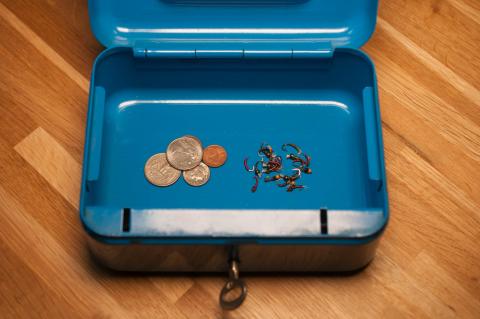Recent comments
Good afternoon, I'm looking for a way to acquire miss sharon bucktail streamer fly. For the last six months i've been working on the boat of this flies original designer, alongside arthur libby's son on their 1968 30' christ craft cavalier. If anyone has any information on acquiring any of these flies, or someone available to prefabricate them, it would be greatly appreciated. I would love to be able to supply the boat with the exact components used by Arthur lobby over 30 years ago. Thank you all for your time.
- Log in to post comments
After reading your text Martin, I bought Klink at Gary Hankle's store here in Canada. As you mention, this book is worth the asking price without a doubt. Thanks. What would we be without special character in this weird world ?!?!
- Log in to post comments
Loved your carefully considered and fair review Martin. Just to let you know that it was us as publishers who came up with the book title and sub-title The Extraordinary Genius of Hans van Klinken, with a bit of help from grayling expert and friend John Roberts. Hans is larger than life, full of enthusiasm and drive, but as you rightly point out he is generous in giving credit to other flytyers and he doesn't blow his own trumpet. He has been a delight and a surprising laugh to publish and we all hope that the 40th anniverary of the Klinkhamer throughout this year is a lot of fun internationally.
- Log in to post comments
P.O.S. Spits small flies, don't even need to be touching them.
A $50 vice grips better than this garbage.
- Log in to post comments
Hi. I am a new tyer out of California and I saw this Streamer online and would love to try tying it but can't find the long hooks. Can you help me please? It's the Grey ghost fly. Thx!
John
- Log in to post comments
I have agree with you on the Regal vise. I tied on one for a few years until the jaw chipped. This is almost inevitable if you tie smaller flies - more a matter of when than if in my opinion. Contacted Regal and wanted to charge me for a new set of jaws which I thought was unacceptable for a vise with an obvious design flaw that supposedly has a lifetime guarantee. I switched to a Renzetti Presentation 2000 and haven't looked back.
- Log in to post comments
Again:
Nice fly :-)
I love the simple patterns - they are quick for tying, effective on the water and look nicely.
Good job.
- Log in to post comments
I love my Law vise and have been tying on it for the last 20 years. I have 4 HMH Spartan vices for fly tying classes and for 20 years prior it was a Renzetti traveler that I still have. I bought the Law right before becoming a dad and it was a big investment at the time. At first I was a little let down with the simplicity but I honestly can’t imagine on tying on anything else. From large striper saltwater flies to size 20 midges, never an issue whatsoever. Seeing that my investment has grown, I will now make sure its clean as when I am done with it my sons can split the proceeds!!! Puts a smile on my face!!
- Log in to post comments
A 30-year adventure like GFF is rare. The people who launch and support these good ideas burn out and/or are forced to transform the initial project into a commercial activity and often, this is the prelude to the end. The rare cases that survive are held at arm's length by a tough headstrong or a crazy enthusiast who makes it a personal mission. Thank you martin for possibly being a mix of the two.
- Log in to post comments
The best all around streamer: seabass, asp, perch, tarpon, jack, chub, snapper... I use it mostly with white /grizzle/chartreuse or purple/black. I put bit more flash but I make the throat of calf tail to make a hot spot. And of course yellow stick on eyes and UV resin head.
- Log in to post comments
Don’t worry, Google won’t loose anything cause you stop counting. If this free time give birth to + 1 publication per year or more time with Brigitte and/or fishing, well we all gain here. Obviously , more time for you and your love is first. Take care Martin.
- Log in to post comments
I got an email from Trevor, with this information:
---------------
I have been out of action for a while now because of ill health but am pleased to say that I have a stock of my Javelin fly lines available.
I now live in Ireland and my current email is : tmorganmayo@gmail.com
My phone/WhatsApp number is +353 873492524.
---------------
Martin
- Log in to post comments
Paul,
The sample cards and silk spools are typically available in shops catering to tyers who tie classical salmon flies, and I have seen (and bought) silk from dealers here in Denmark. Simply searching for Japanese silk floss gives a lot of possible sources for original Japanese silk.
Regarding places in Japan, I'm not able to help you right off the bat. Finding locations there will probably require some research. I have a few Japanese fly tyers in my network, and I can try asking around, but my guess is that doing some online research might unearth some tips. Silk is typically connected with kimonos in Japan and combining silk, floss and kimono may give something.
I tried: https://www.google.com/search?q=silk+floss+factory+japan and https://www.google.com/search?q=silk+floss+kimono+factory+japan and these searches did give some pointers that could be useful.
I'll see if I can find more.
Martin
- Log in to post comments
I am visiting multiple cities in Japan next month. I am looking for the source that the author used to buy their silk and sample card and am wondering if there is a retail source I can visit during my trip. Thank you so much for your time.
- Log in to post comments
Peter,
Your findings match my own experiences with almost any spooled material: tinsel, wire, monofilament ... you name it. We can't use terms like small, medium, large, wide, narrow, thin, thick for anything! We need absolute measurements in fractions of an inch or millimeter (preferably both), so that there can be no doubt and things can be compared.
And don't get me started on hooks where the problem is the same. I have worked on an article on hook sizes, which is just as confusing with numbered sizes that vary wildly from company to company and are totally crazy even from the same manufacturer.
It's 2024 and you'd think that the industry would be as interested as us consumers in updating these measures and units, of which most were invented up towards two centuries ago.
But that doesn't seem to be the case. We're stuck with 1/0, 5 weight, medium and all kinds of odd and almost useless units.
My thread table is a feeble try to get a little order into that part of our world. I'm glad it's helpful.
Martin
- Log in to post comments
Thank you Martin, This is really helpful! Compiling it and updating it must take a lot of work, Thank you so much.
I recently entered a fly tying competition run by a print and digital magazine I subscripe to. The first fly is tied on a size 12 hook, the second on a size 10 hook. What I find confusing in the materials list is 'Fine Silver Wire'. I checked my stock from 3 different manufacturers, Measured by vernier calliper my discovery is as follows:
Veniards:Fine: 0.125mm (No. 27) ( actual 0.12mm), Medium: 0.155mm (No. 26), Large/Wide: 0.185mm (No. 25).
Uni-Soft: Small 0.15mm (No. 33) Between medium and large?, UTC Wire:X-Small: 0.1mm, Small: 0.16mm, Brassie: 0.22mm
Medium: 0.32mm.
Fly-Box: Micro/Small 0.10mm, Medium 0.20mm.
Again not much consistency across the sizes, so I guess we need to purchase from different suppliers so we can match diameters to the fly we are tying. This doesn't help us elderly folk dependant on our retirement pension!
Across my stock Small varies from 0.15mm, 0.16mm, 0.10mm.
Meduim varies from 0.155mm, 0.32mm, 0.20mm.
Thank you Martin for excellent work as always.
Best regards
Peter Jackson
- Log in to post comments
Hey Nick,
Thanks for the heads-up on that fly tying video by Piscator. I had not seen it before at: https://www.youtube.com/watch?v=xRrTmAWvF2I
Cheers!
Rory
- Log in to post comments
Hi Rory,
Glad you liked the worm.I looked up Ridj-bak flies and found a You Tube video on a Steelhead pattern that looked good. I've used chain along the back of a curved hook to tie shrimps with a dubbing loop wound between the beads and then a shell back pulled over.
Cheers, Nick
- Log in to post comments

